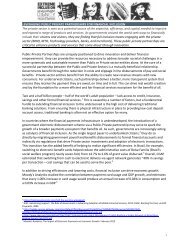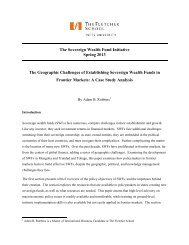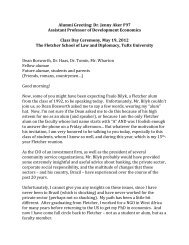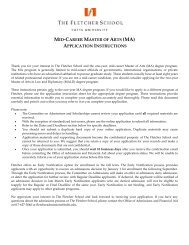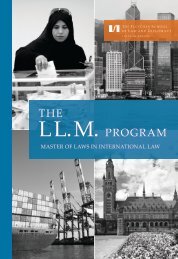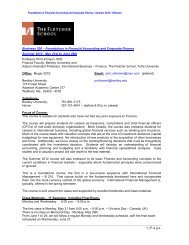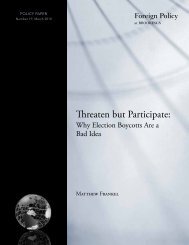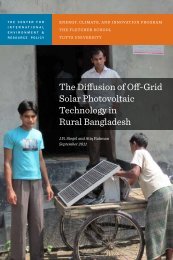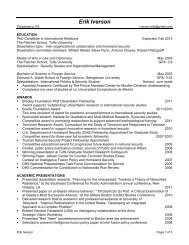A Preface for "Resilience:Interdisciplinary Perspectives in Science ...
A Preface for "Resilience:Interdisciplinary Perspectives in Science ...
A Preface for "Resilience:Interdisciplinary Perspectives in Science ...
- No tags were found...
Create successful ePaper yourself
Turn your PDF publications into a flip-book with our unique Google optimized e-Paper software.
©2010 Editor and Author/sThe word “identity” <strong>in</strong> the def<strong>in</strong>itionabove is important. It implies that thesystem can have the same identitywhile undergo<strong>in</strong>g changes, but only upto a po<strong>in</strong>t. If change exceeds somecritical amount then the system is nolonger able to self-organise <strong>in</strong> the samek<strong>in</strong>d of way, and it changes to someother way of function<strong>in</strong>g, with adifferent structure and differentregulat<strong>in</strong>g feedbacks – and it developsa different identity (Cumm<strong>in</strong>g et al2005).It was this word „identity‟ thattriggered the <strong>in</strong>itial <strong>in</strong>teraction betweenme and Astier Almedom (the <strong>in</strong>itiatorof this Journal). She, too, had focussedon identity as the def<strong>in</strong><strong>in</strong>g feature thatcaptured critical change <strong>in</strong> thepsychosocial transition people make <strong>in</strong>the aftermath of disasters (Almedom,2004; Almedom and Tumw<strong>in</strong>e 2008).<strong>Resilience</strong> of <strong>in</strong>dividuals, families,communities and <strong>in</strong>stitutions isdeterm<strong>in</strong>ed by their capacity toma<strong>in</strong>ta<strong>in</strong> their identity whileundergo<strong>in</strong>g trans<strong>for</strong>mations (adapt<strong>in</strong>gto adversity) through persistence withrout<strong>in</strong>e functions and rituals whichmake them who they are as people,communities, cultures, nations and/or<strong>in</strong>stitutions. Human agency anddeliberate action to ma<strong>in</strong>ta<strong>in</strong> one‟s<strong>in</strong>tegrity is where we differ <strong>in</strong> th<strong>in</strong>k<strong>in</strong>gabout identity. An ecosystem‟s identityis described by the functions andcontrols that dist<strong>in</strong>guish it, whilehuman identity is imbued with agency,customs, rituals, and deliberate action.Ecosystems and people are sel<strong>for</strong>ganis<strong>in</strong>g,complex adaptive systemswith non-l<strong>in</strong>ear dynamics. They canexist <strong>in</strong> multiple (alternate) stabilitydoma<strong>in</strong>s, or „regimes‟, and the shiftfrom one to another is triggered whenthey cross some critical threshold. Anda crucial po<strong>in</strong>t is that the positions ofsuch thresholds are not fixed. What wedo to ecosystems, and the k<strong>in</strong>ds ofnatural and social environments thatpeople live <strong>in</strong>, <strong>in</strong>fluence how muchthey can change be<strong>for</strong>e they reach athreshold, which is a measure of theirresilience.If there is no possibility of „regimeshifts‟ (cf Scheffer and Carpenter2003), no possibility of „tipp<strong>in</strong>g po<strong>in</strong>ts‟<strong>in</strong> human behaviour, or thresholdeffects <strong>in</strong> ecosystems, then there is nofundamental problem <strong>in</strong> resourcemanagement or <strong>in</strong> human welfarebecause the system is always smoothlyreversible. It is globally stable andrecovery is always possible withoutmajor <strong>in</strong>terventions. In non-l<strong>in</strong>earsystems, however, the likelihood ofalternate system regimes is high and ashift (<strong>in</strong>tended or un<strong>in</strong>tended) from oneto the other can be irreversible, or veryhard to reverse. <strong>Resilience</strong>management there<strong>for</strong>e places anemphasis on identify<strong>in</strong>g alternateregimes and what determ<strong>in</strong>es thethresholds between them.I conclude with a few observations,emerg<strong>in</strong>g from comparative analysesof resilience <strong>in</strong> various regions of theworld (see, <strong>for</strong> example, Walker et al2006), on actions that can build orreduce resilience.Prob<strong>in</strong>g the boundaries of resilienceKeep<strong>in</strong>g th<strong>in</strong>gs constant reducesresilience. A common objective ofpolicies aimed at optimiz<strong>in</strong>g someparticular product or outcome is toidentify an „optimal‟ state of thesystem, and then to somehow try andkeep it <strong>in</strong> that particular state. In fact,keep<strong>in</strong>g a system <strong>in</strong> one particular stateleads to self-organized changes thatmake the system less and less resilient.As an example, prevent<strong>in</strong>g fire <strong>in</strong> a<strong>for</strong>est <strong>in</strong> an attempt to keep it <strong>in</strong> its<strong>Resilience</strong>: <strong>Interdiscipl<strong>in</strong>ary</strong> <strong>Perspectives</strong> on <strong>Science</strong> and Humanitarianism, Volume 1, March 2010ii



